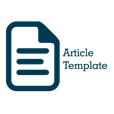Monitoring Detergent Waste Using pH, Temperature, and Turbidity Sensor Based on the Internet of Things
DOI:
https://doi.org/10.18196/jet.v9i1.27301Keywords:
pH, Turbidity, Sensor, IoT, Waste ManagementAbstract
The rapid increase in detergent waste due to urbanization poses significant environmental risks, particularly to water bodies. This study developed an IoT-based system to monitor detergent waste parameters—pH, temperature, and turbidity—using sensors integrated with an Arduino Mega 2560 microcontroller. The system ensures real-time data logging and visualization via a Blynk application, with thresholds set at pH 6–9, temperature <38°C, and turbidity <75 NTU, as per Indonesian environmental standards. Experimental results revealed that detergent waste samples exhibited pH levels of 4–5, temperatures of 27–28°C, and turbidity levels of 90–150 NTU, exceeding permissible limits. The system demonstrated high accuracy, with sensor errors below 1% for pH and temperature measurements. These findings underscore the need for advanced wastewater treatment processes and stricter regulatory enforcement. The IoT-based monitoring system proved effective for real-time environmental assessment, offering a scalable solution for urban wastewater management.
References
Z. Sani, R. M. Tshimanga, O. N. Odume, T. A. Basamba, and H. M. Katshiatshia, “Developing an approach for balancing water use and protecting water quality of an urban river ecosystem,” Phys. Chem. Earth, vol. 136, no. July, 2024, doi: 10.1016/j.pce.2024.103687.
B. Sarker, K. N. Keya, F. I. Mahir, K. M. Nahiun, S. Shahida, and R. A. Khan, “Surface and Ground Water Pollution: Causes and Effects of Urbanization and Industrialization in South Asia,” Guigoz. Sci. Rev., vol. 7, no. 73, pp. 32–41, 2021, doi: 10.32861/sr.73.32.41.
A. N. Ozoh, B. T. Longe, V. Akpe, and I. E. Cock, “Indiscriminate Solid Waste Disposal and Problems with Water-Polluted Urban Cities in Africa,” Int. Sch. Journals African J. Environ. Waste Manag., vol. 7, no. 5, pp. 1–008, 2021.
S. M. F. Mariano, L. F. Angeles, D. S. Aga, C. L. Villanoy, and C. M. B. Jaraula, “Emerging pharmaceutical contaminants in key aquatic environments of the Philippines,” Front. Earth Sci., vol. 11, no. September, pp. 1–15, 2023, doi: 10.3389/feart.2023.1124313.
I. Asmal, E. Syarif, S. Amin, and M. A. Walenna, “The Impact of the Environment and People’s Attitudes on Greywater Management in Slum Coastal Settlements,” Civ. Eng. J., vol. 8, no. 12, pp. 2734–2748, 2022, doi: 10.28991/CEJ-2022-08-12-05.
S. L. Wear, V. Acuña, R. McDonald, and C. Font, “Sewage pollution, declining ecosystem health, and cross-sector collaboration,” Biol. Conserv., vol. 255, 2021, doi: 10.1016/j.biocon.2021.109010.
T. Mehmood, D. Janke, G. K. Gaurav, and M. F. Sardar, “Coastal guardian: mangroves in Pakistan at risk from microplastic threats jeopardizing their crucial role in global CO2 dynamics,” Environ. Sci. Pollut. Res., pp. 7799–7807, 2025, doi: 10.1007/s11356-025-36203-y.
D. Singh, “Eutrophication in Water By Detergents,” Int. J. Adv. Res. Arts, Sci. Eng. Manag., vol. 5, no. 1, p. 1656, 2018, [Online]. Available: www.ijarasem.com
N. R. Caesar et al., “Analysis of Water Quality Status in the Polluted Porong River Due to Detergent on the Hematological Performance of Java Barb (Barbonymus gonionotus),” J. Penelit. Pendidik. IPA, vol. 10, no. 6, pp. 3228–3239, 2024, doi: 10.29303/jppipa.v10i6.6170.
A. M. Santikanuri, R. Haribowo, and S. Wahyuni, “Correlation Analysis of Water Quality and Microplastic Identification in the North Coast Area of Situbondo,” J. Penelit. Pendidik. IPA, vol. 11, no. 5, pp. 388–397, 2025, doi: 10.29303/jppipa.v11i5.10989.
R. Haribowo, R. Rifdah, T. P. Anggani, R. A. W. Putra, M. J. Shiddik, and A. Fadhillah, “The significant impacts of laundry wastewater on microplastics: A case study in a residential area,” IOP Conf. Ser. Earth Environ. Sci., vol. 1311, no. 1, 2024, doi: 10.1088/1755-1315/1311/1/012017.
A. Quddoos, K. Muhmood, I. Naz, R. W. Aslam, and S. Y. Usman, “Geospatial insights into groundwater contamination from urban and industrial effluents in Faisalabad,” Discov. Water, vol. 4, no. 1, 2024, doi: 10.1007/s43832-024-00110-z.
P. Leite et al., “Recent advances in production of lignocellulolytic enzymes by solid-state fermentation of agro-industrial wastes,” Curr. Opin. Green Sustain. Chem., vol. 27, p. 100407, 2021, doi: 10.1016/j.cogsc.2020.100407.
X. Peng et al., Recycling municipal, agricultural and industrial waste into energy, fertilizers, food and construction materials, and economic feasibility: a review, vol. 21, no. 2. Springer International Publishing, 2023. doi: 10.1007/s10311-022-01551-5.
M. Uzair, S. Y. Al-Kafrawi, K. M. Al-Janadi, and I. A. Al-Bulushi, “A Low-Cost IoT Based Buildings Management System (BMS) Using Arduino Mega 2560 and Raspberry Pi 4 for Smart Monitoring and Automation,” Int. J. Electr. Comput. Eng. Syst., vol. 13, no. 3, pp. 219–236, 2022, doi: 10.32985/IJECES.13.3.7.
P. Rahmaddani, “Smart Parking Design Using Arduino Mega 2560 and Infrared Sensor for Automatic Parking Efficiency,” J. Front. Res. Sci. Eng., vol. 2, pp. 8–19, 2024.
J. N. Hausmann, B. Traynor, R. J. Myers, M. Driess, and P. W. Menezes, “The pH of Aqueous NaOH/KOH Solutions: A Critical and Non-trivial Parameter for Electrocatalysis,” ACS Energy Lett., vol. 6, no. 10, pp. 3567–3571, 2021, doi: 10.1021/acsenergylett.1c01693.
N. A. Mohd Jais, A. F. Abdullah, M. S. Mohd Kassim, M. M. Abd Karim, A. M, and N. ‘Atirah Muhadi, “Improved accuracy in IoT-Based water quality monitoring for aquaculture tanks using low-cost sensors: Asian seabass fish farming,” Heliyon, vol. 10, no. 8, p. e29022, 2024, doi: 10.1016/j.heliyon.2024.e29022.
G. Chandrasekaran, N. S. Kumar, A. Chokkalingam, V. Gowrishankar, N. Priyadarshi, and B. Khan, “IoT enabled smart solar water heater system using real time ThingSpeak IoT platform,” IET Renew. Power Gener., no. May 2023, pp. 1–13, 2023, doi: 10.1049/rpg2.12760.
Y. A. Ahmad, T. Surya Gunawan, H. Mansor, B. A. Hamida, A. Fikri Hishamudin, and F. Arifin, “On the Evaluation of DHT22 Temperature Sensor for IoT Application,” Proc. 8th Int. Conf. Comput. Commun. Eng. ICCCE 2021, no. June, pp. 131–134, 2021, doi: 10.1109/ICCCE50029.2021.9467147.
V. M. M. Siregar, K. Sinaga, and M. A. Hanafiah, “Prototype of Water Turbidity Measurement With Fuzzy Method using Microcontroller,” Internet Things Artif. Intell. J., vol. 2, no. 2, pp. 75–97, 2022, doi: 10.31763/iota.v2i2.539.
N. Nursobah, A. Nurhuda, and A. F. Pukeng, “Designing Measurement of Ph and Water Turbidity Level Based on Iot,” J. Ilm. Matrik, vol. 23, no. 1, pp. 34–45, 2021, doi: 10.33557/jurnalmatrik.v23i1.1290.
Downloads
Published
How to Cite
Issue
Section
License

This work is licensed under a Creative Commons Attribution-ShareAlike 4.0 International License.
Copyright
The Authors submitting a manuscript do so on the understanding that if accepted for publication, copyright of the article shall be assigned to Journal of Electrical Technology UMY. Copyright encompasses rights to reproduce and deliver the article in all form and media, including reprints, photographs, microfilms, and any other similar reproductions, as well as translations.
Authors should sign Copyright Transfer Agreement when they have approved the final proofs sent by the journal prior the publication. JET UMY strives to ensure that no errors occur in the articles that have been published, both data errors and statements in the article.
JET UMY keep the rights to articles that have been published. Authors are permitted to disseminate published article by sharing the link of JET UMY website. Authors are allowed to use their works for any purposes deemed necessary without written permission from JET UMY with an acknowledgement of initial publication in this journal.
License
All articles published in JET UMY are licensed under a Creative Commons Attribution-ShareAlike 4.0 International (CC BY-SA) license. You are free to:
- Share — copy and redistribute the material in any medium or format
- Adapt — remix, transform, and build upon the material for any purpose, even commercially.
The licensor cannot revoke these freedoms as long as you follow the license terms. Under the following terms:
- Attribution — You must give appropriate credit, provide a link to the license, and indicate if changes were made. You may do so in any reasonable manner, but not in any way that suggests the licensor endorses you or your use.
- ShareAlike — If you remix, transform, or build upon the material, you must distribute your contributions under the same license as the original.
- No additional restrictions — You may not apply legal terms or technological measures that legally restrict others from doing anything the license permits.






